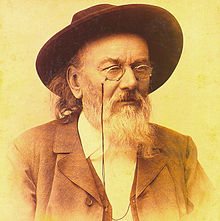Vilmos Zsolnay
Vilmos Zsolnay (born April 19, 1828 in Pécs ; † March 23, 1900 there ) was a Hungarian ceramic artist and industrialist.
biography
Although he wanted to become a painter, following his father's wish, he took over the family business in 1853 and, 10 years later, his brother's clay factory. While he expanded the factory, he remained a visual artist. The development of new ceramic materials was particularly important to him. His inventions are porcelain faience and the freeze-proof pyrogranite used to decorate buildings .
Together with Vince Wartha , he developed the luster technique with eosin to refine the ceramics. In his factory, he was the first to apply this method to jewelry. From 1873 he was successful with this invention in domestic and foreign exhibitions. At the height of his career, he received gold medals at the Paris World's Fair in 1878 and was accepted into the French Legion of Honor . He later received the Franz Joseph Order and honorary citizenship of the city of Pécs.
As a designer, he was the first major employer for visual artists, such as B. Ármin Klein . Important architects of the time made a preference for Zsolnay's building ceramics, including:
- Imre Steindl
- Ödön Lechner
- Aladár Árkay
- Flóris basket
- Kálmán Giergl
- Béla Lajta
- Samu Pecz
- Frigyes Schoolk
After his death, his son Miklós Zsolnay continued the manufacture, in which he already played a decisive role during his father's lifetime.
The factory is still in operation today. After the nationalization, it was named Pécsi Porcelángyár ("Pécs Porcelain Factory"). She is known for the production of artistic ceramics and the processing of eosin.
Picture gallery
The fountain with the building of the Merciful Brothers of Maria Hilf in the background
Web links
- Homepage of Zsolnay Porcelánmanufaktúra. Zsolnay Porcelánmanufaktúra Zrt., March 31, 2008, archived from the original on February 8, 2007 ; Retrieved on March 20, 2008 (German, information on the history of the Zsolnay family and the manufacture, as well as current communications).
- The Vilmos Zsolnay statue. Pécs.portal, archived from the original on February 17, 2013 ; accessed on November 20, 2008 (German).
- Joy of color and exoticism. Hungarian Art Nouveau ceramics from the Zsolnay factory, Pécs. (pdf; 101 kB) Janus Pannonius Museum Pécs, p. 4 , accessed on November 20, 2008 (German, excerpts from the exhibition didactics).
- More than 150 years of porcelain from the Zsolnay tradition are an obligation. Hungary Info, February 11, 2006, accessed November 20, 2008 (German).
| personal data | |
|---|---|
| SURNAME | Zsolnay, Vilmos |
| BRIEF DESCRIPTION | Hungarian ceramic artist and industrialist |
| DATE OF BIRTH | April 19, 1828 |
| PLACE OF BIRTH | Pécs |
| DATE OF DEATH | March 23, 1900 |
| Place of death | Pécs |





